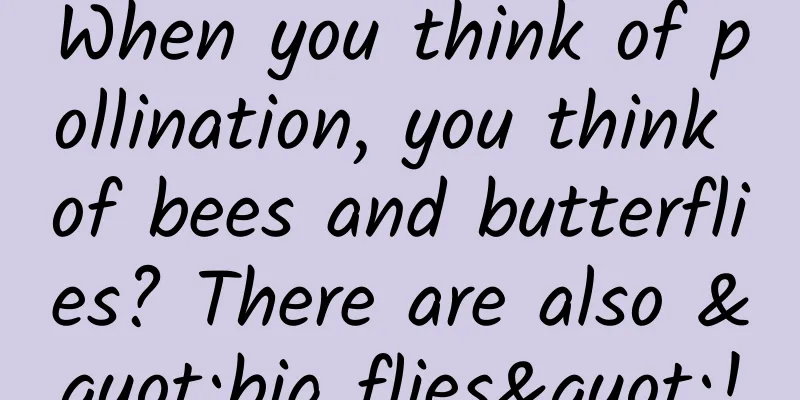When you think of pollination, you think of bees and butterflies? There are also "big flies"!

|
When we think of wildlife in cities, we often forget about the tiny but essential part of the ecosystem: pollinators . They live right next to us in urban green spaces, keeping the ecosystem going in the mundane ways. Have you ever observed the pollinators in your city? Some insects that look like bees are actually giant flies! Some pollinators love to eat plants that are actually the source of allergies that make you sneeze (people don’t share the same joys and sorrows, and the same is true with insects). The Beijing Pollination Network Observation Report (2021-2023) was jointly released by Shanshui Nature Conservation Center, Professor Zhou Xin and his team from the College of Plant Protection of China Agricultural University, and Beijing Academy of Landscape Architecture. How many little secrets do pollinators have? The "Beijing Pollination Network Observation Report (2021-2023)" released some time ago uses Beijing as a research city to reveal the urban life of pollinators . Insect Neighbors in the City Since 2021, the Shanshui Nature Conservation Center has cooperated with Professor Zhou Xin and his team of students from the College of Plant Protection of China Agricultural University to carry out the "Beijing Urban Pollination Network Survey and Protection" project. The project selected six sample lines including the Olympic Forest Park (Osen) and the National Botanical Garden for follow-up surveys. In the survey records, the number of honey bees in the order Hymenoptera is overwhelming, and the number of honey bees (Apis cerana) is the largest . This phenomenon may be related to the presence of a population of honey bees raised near the sample site. Honey bees were introduced to China in the early 20th century for the production of honey, but they also formed a competitive relationship with the native Oriental honey bees (Apis cerana) . The two types of honey bees are very similar and have similar diets, and can be distinguished by the veins on their wings. In addition to these two common bees, the pollinating insects of the order Hymenoptera include various types of tunnel bees, leafcutter bees with pollen brushes growing on their bellies, etc. They have a wide range of diets and can pollinate a wide variety of plants. Western honey bees (left) and Eastern honey bees (right) | Paul Zborowski/Queensland Government There is another common type of small insect that is often mistaken for a bee, and that is the hoverfly of the order Diptera . Most of them have black and yellow body colors, but if you look closely, you will find that they have a pair of huge fly-like compound eyes on their heads, their antennae are relatively short and not obvious, and they do not have pollen baskets on their legs. By imitating the appearance of bees and wasps, hoverflies reduce their own risk of being preyed upon. Like bees, their adults also pollinate a variety of plants, and the larvae of some species are natural enemies of aphids, which is the origin of their name "hoverflies". Next time you see an insect that looks like a bee in a bush, take a closer look: Is it a Chinese bee, a Western bee, or a hoverfly? Insect observation always brings the fun of opening a blind box! Black-banded hoverfly (Episyrphus balteatus) | Wikipedia In addition to the common bees and hoverflies, there are other pollinating insects - butterflies and moths that usually pollinate long tubular flowers; beetles that mainly pollinate plants such as magnolias and cycads; and various ants of the Formicidae family that pollinate plants such as vitex and hibiscus. You may be allergic to the plants they love to eat In order to understand what pollinators eat, the research team collected pollen from flowering plants and pollinators for analysis. The survey found that the number of plants has little to do with what pollinators eat, and the plants that pollinators like are quite different from those favored by humans . Plants that attract a large number of pollinating insects mainly include Jerusalem artichokes and Brassica (among which honey bees contribute a large number of flower visits). Jerusalem artichokes are horticultural plants of the Asteraceae family native to America, commonly known as "false sunflowers" in English, and are often used to create flower sea landscapes. Brassicas include common vegetables such as cabbage, rapeseed, and mustard. After the butterflies have eaten them, it's our turn to eat them. Jerusalem artichoke | Wikipedia Many of the weeds in the eyes of humans are important nectar plants . Other famous plants on the list of "insect canteens" include the genus Asteraceae and the genus Vitex of the Lamiaceae family . Asteraceae is a very common "small yellow flower on the roadside". Vitex is a type of shrub or tree that blooms clusters of tiny flowers (panicles) in white, light blue, light blue-purple or light yellow. Vitex is a common Vitex plant. Sharp-cracked false ginseng|Mossotrichum Humulus, which causes great pain to people with pollen allergies in autumn, is also a favorite food of pollinating insects. From August to October every year, Humulus produces tiny pollen, which is spread by wind. Although component analysis shows that this type of pollen has low nutritional value, in the eyes of pollinating insects, it is like fast food, " large in quantity and full in quantity", and is a rare food source in the bleak autumn. Black-banded hoverfly visiting Humulus | Titfly In general, bees and hoverflies show a strong preference for native plants , such as Commelina, Oxalis, Rubia cordifolia, Sanguisorba officinalis, Taraxacum officinale, Duchesnea indica, Vitex truncatula, etc. The large fields of sunflowers, Jerusalem artichokes and Autumn lilies planted in Ao Sen are still not as attractive to insects as the small amount of native shrubs such as Lespedeza. Native shrub Lespedeza | Wikipedia Common melon and fruit crops such as cucumbers and winter melons are also important food sources for hoverflies, which reflects the important role of hoverflies in agricultural production. How to leave the "Insect Canteen" Pollinators play a key role in maintaining ecosystem stability and plant diversity. They and pollinating plants form a complex network of interactions. However, this survey found that "the pollination network formed by the food plants provided by Beijing's large green space system and the pollinating insects they attract is not so perfect , and the ecological and protective functions of urban green spaces have not been fully utilized." By the end of 2023, Beijing's urban green coverage rate has reached 49.8%. However, overall, the proportion of native plants in urban greening is relatively low , and the diversity of trees, shrubs, and herbaceous plants is not rich enough . Among them, native flowering shrubs are particularly worth mentioning. Under the premise of the same planting area, they can provide more flowers and richer three-dimensional collection space than flowering herbaceous plants, thus better meeting the needs of insects such as Chinese bees. However, during the investigation and practice, the research team found that the sources of native plant seedlings and seeds in the market are very limited , and promoting their planting is difficult. It requires joint efforts from the gardening department and the market to make changes. Vitex is a native shrub in the northern region|Zhao Zhao The report also points out that pesticide spraying and mowing in garden management may also cause a devastating blow to the pollination network. Excessive weed removal will cause many pollinating insects to lose their food source . While pesticide spraying kills pests, it also kills natural enemy insects such as aphid flies, wasps, and wasps. If these insects that feed on pests disappear, we will have to rely more on pesticides, forming a vicious cycle. As ordinary people, we can also contribute to protecting the diversity of pollination networks in various ways. If you have your own garden or balcony, you can try to plant some native plants and flowering plants , or prepare an insect hotel in a sunny location to see if there are any insects coming to visit. It is also a very pleasant thing to be able to observe nature at home. In addition, you can also participate in local citizen science projects , such as the Shanghai Pollinator Survey, the Guangdong-Hong Kong-Macao Cities "Where are the Honey Plants" citizen science activities, etc. Being more tolerant of insects in parks and green spaces and encouraging people around you to recognize and protect insects is also something that every nature lover can do. References [1] Cui Jingyun, Zhang Shuyi, Mo Fei, Song Yuexin, Cao Yu, Zhang Chenyu, Tan Lingdi, Wan Yiyi, Li Xiaoya, Gu Lei, Zhou Xin. (2024). Beijing Pollination Network Observation Report (2021-2023). Shanshui Nature Conservation Center. 2024.12 Beijing, China [2] Beijing Municipal Garden and Greening Promotion Center. (2024, September 6). Building a garden city in the capital and composing a beautiful chapter in Beijing. Beijing Garden and Greening. https://mp.weixin.qq.com/s/vZKwOQA4bdiPmrgqbs_khA Author: Maya Blue Edited by: Yellowtail Pollock This article comes from GuokrNature (ID: GuokrNature) If you need to reprint, please contact [email protected] |
<<: Why do I always want to stick my feet out of the quilt when I sleep?
Recommend
Apple acquires French image recognition company, may embed technology into iPhone
Tencent Technology News: In the new iPhone X that...
The three levels of conversion analysis: do you understand both product and operation?
Conversion analysis is the most core and critical...
How to enjoy the big screen treatment of mobile games? Lebo Game Hall gives you fun
With the advent of the smartphone era, in additio...
The latest news on the Guangzhou epidemic in 2022: Is the city closed today? What is the risk level?
From 0:00 to 4:00 on April 10, 31 provinces (auton...
Baidu Promotion | Double 11 e-commerce marketing strategy
This article shares with you [ Baidu promotion do...
Analysis of ICBC's competitive products!
With the continuous penetration of the Internet i...
Who is responsible for an accident involving a driverless vehicle? Hangzhou City has given the answer: the owner of the vehicle
As the technology of intelligent vehicles matures...
Taking daily chemicals as an example, how to make your information flow copy stand out?
The products in the daily chemical industry gener...
iOS 17 update, major features return!
Early this morning, Apple pushed the iOS 17 beta ...
Download Tang Xiaoxiao's Story Writing Class on Baidu Cloud
Tang Xiaoxiao's Story Writing Class Resource ...
A Century of Advertising and Marketing
On the day JWT was merged with digital marketing ...
What are the promotion strategies used by platforms such as Tencent, Baidu, and Bytedance?
What trends are shown in advertising placement on...
Electronic power steering may suddenly fail. Geely will recall 40,000 Borui vehicles
Recently, Zhejiang Geely Automobile Co., Ltd. fil...
How to cold start brand operation and promotion?
What is the cold start of a new brand? New brand,...









